
Structures:
Martin Puryear
“Untitled”
1993-1994
Mortared fieldstone, 18 x 14 feet
Oliver Ranch, Geyersville, California
Photo by Wardell Photography
© Wardell Photography
“The stoneworker was a crucial part of this whole process.
He was fascinated by the idea that he was doing something
that would end up having an identity as an art object rather
than a utilitarian structure, a house or building, and that
it was actually going to exist as an independent object for
contemplation and to assume the identity of an art piece.
That, to him, was fascinating.”
— Martin Puryear
1 comentário:
Martin Puryear (born May 23, 1941) is an African American sculptor. He was born in Washington, D.C., and he spent his youth studying practical crafts, learning how to build guitars and furniture. His work is often described as a union of minimalism and these traditional crafts. Puryear works in media such as wood, stone, tar, and wire.
Martin Puryear’s work is the product of much thought, assembled in a minimalist, simple design. Two of his main works are Sanctuary and Box and Pole. The latter’s simplicity is evident just by analyzing its simple title. Box and Pole is comprised of a box on the ground with a hundred foot pole jutting upwards to the sky, therefore symbolizing our position on earth. We are superior to some things (the box), yet inferior to others (God). He is clearly a modern sculptor, but in works such as Sanctuary he uses primitive techniques to create his final work. Sanctuary is basically a stick connecting a box that anchors what is on the other end of the stick, a wheel. The wheel can move, but its movement is restricted, symbolic of human life. His work contributes to society as a whole as it teaches us many moral lessons such as the two mentioned.
The wood that Puryear's Box and Pole is made from is supposed to contrast the abstractness of the sculpture. The box was made four feet so that the average person can look over it making them feel superior. However, the 100 foot pole towering over the box gives off an unreachable feeling. This balances out the feeling of superiority. I wouldn’t say that there is movement, but rather that the audience is “stuck” in a parallel universe between that which he is better than (most of nature) and lesser than (God). When looking down on the box one gets a darker image that is less distorted than when you look up at the pole that is brighter due to the sun, yet more distorted due to its 100 ft distance. So in reality, the box is much clearer than the pole, as nature is much clearer to us than the supernatural God.
In 1982 Puryear made the sculpture Sanctuary. This sculpture is mounted on the wall and was made from pine, maple, and cherry. It is an open box with two thick branches connected to it. The branches extend in a downward motion connecting to the axle of a wheel. Sanctuary relies on both the wall and the floor for support. It is because of this characteristic that the sculpture symbolizes stability and mobility. The box is solid and firmly on the wall, while the wheel is free to rotate on the floor. Yet, the wheel cannot go very far because of the box that is securing it. Puryear's minimalistic ideals come into play here as the wheel is made out of pure wood and the sticks connecting the box and the wheel are tree branches, not even cut. He used absolutely no technology in the creation of this work of art, so it is suffice to say that cavemen thousands of years ago could have created this same work, just devoid of the same thought process. It is so primitive that he chooses to make the wheel completely solid, it lacks such basic parts as spokes. Puryear says that Sanctuary is like many of his other works, they deal with "mobility and a kind of escapism, of survival through flight."
In 2003, he served on the Jury for the World Trade Center Site Memorial Competition. (Wikipedia)
Enviar um comentário